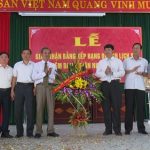Ancestors of the Tran family first settled in Di Ai Commune, Dan Phuong District, nowadays Di Trach Commune, Hoai Duc District. The ancestral temple is an architectural work located in a historical relic complex that was built in Di Trach in the 18th century during the Le Dynasty. This is the place of worship for the family’s ancestors, including successful scholars and mandarins under the Le Dynasty such as Advanced Scholar Tran Mo and Advanced Scholar Tran Gia Muu. On ancestors’ commemoration days and during annual native festivals, generations of the family all gather together at the ancestral temple to pay tribute to the forefathers.

Members of the district’s leadership giving flowers to the family’s representatives
Having undergone historical ups and downs, the Tran family’s ancestral temple has now been restored and embellished, but still retains the unique, yet consonant, ancient architecture that holds in-depth historical values. The architectural values presented on the wooden structures reflect the aesthetic idea and creative style of an era. Many remaining artifacts have the styles of the Le and Nguyen Dynasties, such as: the pair of emerald phoenix, the throne for worship, the horizontal lacquered board, the fabric sheet, the pair of wood panels (on which are inscribed parallel sentences), the ordination box, the copper tripod cauldrons, the wooden incense holder, and the set of cups. The Tran family’s ancestral temple also preserves an imperial ordination decree dated back to the 20th year of Canh Hung, contributing to the cultural beauty of the family and their hometown.
With its historical and architectural values, the Tran family’s ancestral temple in Di Trach Commune was recognized as a city-level celebrity memorabilia historical relic by Hanoi People’s Committee on March 20, 2017.

Mr. Nguyen Anh, Member of District Party Committee, Vice Chairman of District People’s Committee, conferring the certificate of city-level celebrity memorabilia historical relic to the Tran family’s ancestral temple
On May 14, the People’s Committee of Di Trach Commune (Hoai Duc District) held a ceremony for the award of the certificate of city-level celebrity memorabilia historical relic to the Tran family’s ancestral temple. Attending guests were Mr. Nguyen Thanh Hai, Standing Commissioner of District Party Committee, Head of Propaganda and Education Board; Mr. Nguyen Manh Hung, Standing Commissioner of District Party Committee, Head of Mass Mobilization Board; Mr. Nguyen Anh, Member of District Party Committee, Vice Chairman of District People’s Committee; leaders of offices, boards, sectors, Vietnam Fatherland Front district-level branch; leaders of Party Committees, People’s Councils, People’s Committees, Vietnam Fatherland Front commune-level branches, and offices, boards, and organizations at commune level as well as generations of the Tran family.
In his speech at the ceremony, Mr. Nguyen Anh, Member of District Party Committee, Vice Chairman of District People’s Committee, affirmed that the recognition of the Tran family’s ancestral temple as a historical and cultural relic not only met the expectations of the Tran descendants, but also established a legal basis to facilitate the protection and promotion of the relic’s cultural values. To better preserve and promote the historical and cultural values of the relic, he asked the Tran family to focus on the management and preservation of the artifacts, to improve the scenery to increase the sanctity of the relic, to promote the traditions of their ancestors, and to join hands in protecting and preserving the temple. He also asked the young generation to follow the forefathers’ path to academic success to contribute to the development of the homeland and the country./.
Chu Hong

